Human Flower Project
Sunday, May 11, 2008
Cycling to Ashwell, Two Gardens
John Levett rides south of Cambridge to see what generations of nickings, seed droppings, and skill have made: the expected and the surprising.
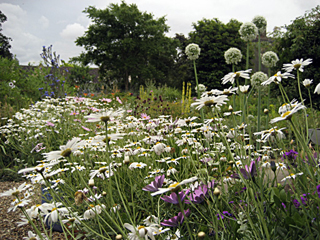
Spring at Docwra’s Manor House, Shepreth, England
Photo: John Levett
By John Levett
I cycle a lot. It’s what I used to do as a kid. Stopped. Then started again forty years later. When I was growing up in South London in the 50s I used to walk over to Lewisham some Saturday mornings, up Loampit Hill then down Tanners Hill into Deptford. Just before hitting Deptford Broadway there’s a small turning and there used to be Witcomb’s cycle shop. I went there to watch the frame builders. They had four or five in those days plus a racing team. Most famously, Stan Britten rode a Witcomb in the 1958 Tour de France. He finished in 69th spot but a Brit taking part in those days was a moment of wonder. I’d get a Witcomb when I went out to work (it said on my list of what to do with money when I got some).
Fast forward forty years to 2001. I decided I wanted a road bike to add to my workhorse that got me places but not fast (nor stylishly) enough and it was then that Witcomb came back into mind. Did they still make bikes? Did they still exist? Never mind looking it up; I hadn’t been down to Deptford for decades. I travelled down from Cambridge at Easter that year, tube to New Cross Gate and down New Cross Road. Still there and as small and grubby as ever it was and Dad Witcomb still behind the counter.

The Witcomb, parked in the garden at Level Crossing, May 2008
Photo: John Levett
To cut to the end I got the bike I wanted as a kid. Made to measure, full road spec, Witcomb lilac and black head tube just like Stan’s. Part of my history. It took until October for Barrie Witcomb (my age, ex-racer, sole frame builder) to complete the bike but I took possession a few days before I had to undergo radiography treatment at Addenbrooke’s Hospital. Each afternoon, after treatment, I took Witcomb out into the Fens and rode through a perfect Autumn.
I love the Fens in any season and they’re not as featureless as pictured; the surprise of villages, the washes, remnants of farmsteads, the island settlements, the Ely towers, trails where there’s nothing and nobody—rare in this part of the kingdom. But no hills.
I often ride over into Essex for variety around Thaxted, Dunmow and the North Weald but my favourite detour is up to the Cambridgeshire hills overlooking Duxford and then over the Hertfordshire border to Reed; Therfield (one of the beacon hills of 1588 announcing the sighting of the Spanish Armada); Kelshall at the eastern end of the Chilterns near Royston; then dipping down into Ashwell whose spring sources the Cam. The church is fine, has a mason’s scratching of the original St. Paul’s cathedral before the Great Fire and graffiti recording the Black Death of 1349. My route from Ashwell back to Cambridge passes through Shepreth (‘the brook in which sheep are dipped’). It’s got two gardens worth a stop; for different reasons.
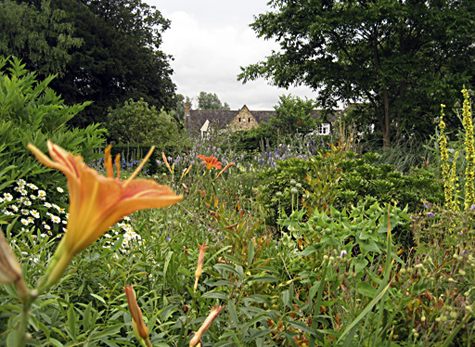
Hemerocallis Fulva points the way to the Manor House, Docwra
Photo: John Levett
Docwra’s Manor House is 17th. century. Its garden’s got a formal informality. Let me explain. When I was learning history one of my teachers was WG Hoskins whose most widely read publication was The Making of the English Landscape; a fine television series came out of it too. He took us out into the Leicestershire countryside and demonstrated how everything that looks natural was in fact built, contrived, purposely located and served a variety of economic, political and social interests. I get that feeling about Docwra’s. It feels too much like how a manor house garden should look; even down to the seat, the sharpening stone, the water butt. On a blisteringly hot day you could think yourself into The Go-Between.
This might seem to be knocking the gardening skills that have gone into its creation. My problem (if problem it is) has always been that, whichever season I’ve been there, I’ve found whatever I’ve expected to find. For me, surprises have been few. Nonetheless, I love going there. Sometimes I like comfortable recognition. I love the mix, the heights, the turns, the contrived skill of the planting.

Docwra’s gardens: successful “experiments”
Photo: John Levett
Docwra’s represents what many gardeners (especially in England) aspire to: a garden that reflects the gardener’s ease and casual facility; an almost-inconsequential dropping of a seed here a cutting there; an accepting awareness that one experiment will succeed, another fail and in the scheme of things all moments pass. Gardening by walking about. Plantings merge. Seed drops. Confusion’s eased into what fits. Sorted.
I contrast it to Beth Chatto’s garden (or gardens) at Elmstead Market in Essex. My Uncle Syd used to live in Brightlingsea nearby and when I visited we often wound up there. (Syd left England in the 1930s for the States, going from one depression to another, looking for work and started off as a seller of Mazawattee tea. He finished up as butler to the Bloomingdales and often featured as a model in adverts in the photogravures of the ‘50s advertising pool-side drinks or crisp, white shirts. He bore a passing resemblance to Alfred, butler to Adam West’s Batman.) Anyway…I first went to Beth Chatto’s in the early ‘80s and got thrilled, bought more than I could afford and wanted back to spend more. It was some years later but by then the commercial side seemed to be doing the driving and a supporting contrivance dominating. I know all gardens are contrivances but this seemed to be up front and centre.
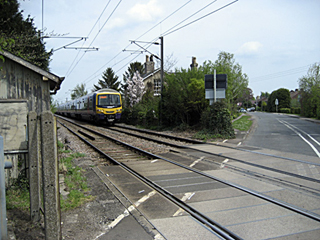 Level Crossing, where the rail line crosses Ashwell Road
Level Crossing, where the rail line crosses Ashwell Road
Photo: John Levett
Docwra’s has the advantage of being just a garden; no ‘Buy one get one free’ of anything. It has confusion too; it’s part of its artifice. A near neighbour has it as well.
The Level Crossing garden is a couple of hundred yards down the road from Docwra’s; at the apex of a triangle formed by Ashwell road and the main line Great Northern railway. These crossings used to be hand operated; gardening was no doubt a way of passing time between trains. I’ve often passed it on a ride but only rarely stopped.
There’s a recognizable trend in urban gardens these days not just for off-the-shelf-as-seen-on-TV gardens but for if-it’s-too-small-pave-it-or-chip-it-over approaches. Thankfully there are still many who see small as challenging—what works, what might work, what’s worth a try, that’s-too-big-but-I-love-it, that’s-too-small-but-it’ll-give-a-season. Cookery.
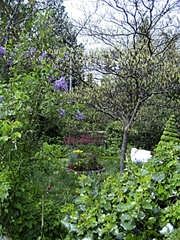 Level Crossing garden, nothing wasted
Level Crossing garden, nothing wasted
Photo: John Levett
Once, there used to be a generation of gardeners who thrived on nicking cuttings (pinchings more likely) from roadsides, other people’s front gardens, stately homes, next door neighbours. It made sense. There might have been a local nursery but unlikely, probably a greengrocer who doubled up on seed packets, possibly a corn chandler who’d do seed potatoes and onion sets in season but many gardeners just picked up plants on the fly or exchanged on the allotment. It was part of communality; but communality needs time to give and stay awhile with neighbours. That’s becoming scarce.
Level Crossing always strikes me as a throw-back to such a time. Nothing wasted, its meanderings Looking-Glass like, its confusions essential. It’s the sort of garden you’d walk daily and recognise something planted seasons ago and forgotten, smile and congratulate yourself on your prime competence.
 A lesson in planning
A lesson in planning
Level Crossing
Photo: John Levett
There is also a confident plan to the garden. I could be wrong but it’s not as casual as it looks. It’s a small plot but the paths that almost turn back on themselves, the siting of bowers & the space beyond that they suggest, the just-slightly enclosed seating, the taller plantings that ‘hedge’ a small bed , the pottings that fill any spare space — create an available space seemingly greater than its extent. That’s always a lesson in Garden Planning 101 but so difficult to achieve in common practice.
I also get the feeling there’s an element of ‘Thrive or Die’ about some of the plantings. We’ve all done it: the must-have that universal experience says is a plant-death waiting to happen but we plant it anyway. I’m reminded of H. persica which is a native of Iran and Afghanistan and was mightily difficult to keep alive in Europe. (John Lindley 1829 “Drought does not suit it, it does not thrive in wet; heat has no beneficial effect, cold no prejudicial influence; care does not improve it, neglect does not injure it.”) Jack Harkness brought it to Hitchin in Hertfordshire the early’ 60s from seed given by Alex Cocker in Aberdeen—it thrived; crossing with such as ‘Canary Bird,’ ‘Cornelia,’ ‘Margo Koster,’ ‘Roseraie de l’Haÿ.’ (I think ‘Euphrates’ was Harkness’s first commercial child in 1986). One feels anything from central Asia would have the same success in Shepreth.
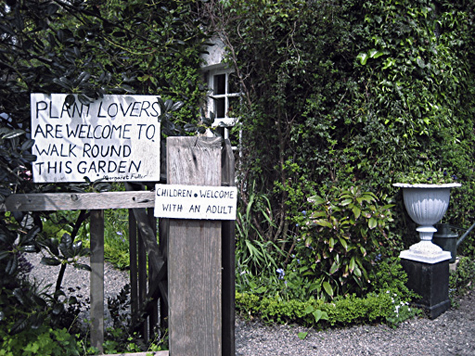
The comfort of a welcome, Level Crossing
Photo: John Levett
There’s another historical comfort to Level Crossing—its openness. Until recently (and in neighbourly streets you still can) you stuck your head into someone else’s garden, walked around, stopped awhile, moaned about the weather and the price of stuff, remembered before the war, swapped plants, gave out left-overs. There’s less of that now; we’re too busy on these islands. Level Crossing’s one of those spots you can stick your nose into; there’s no feeling of taking up someone else’s time. In the housing block where I live, three of us are gardeners and one tries (I take an Aristotelian view of that—to try is to succeed). We won’t win prizes but none are bothered; it’s all in the doing and the sharing; the giving and the trading; the stopping and the nattering. When I walked around Level Crossing it felt like next-door’s garden. But for the train.




